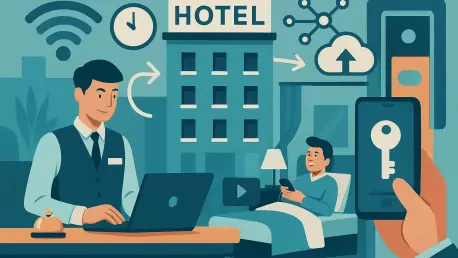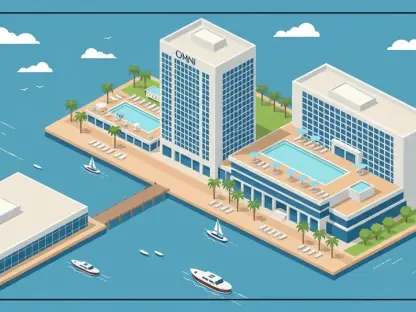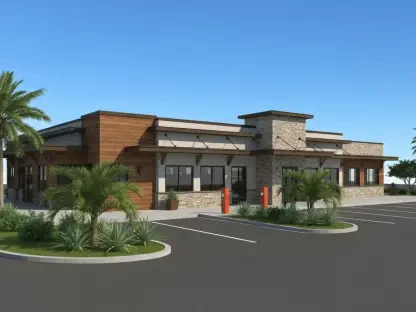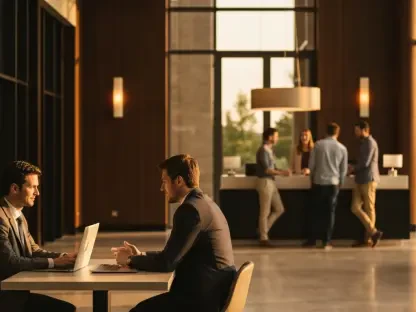What happens when a premier hotel on a bustling university campus struggles with the chaos of outdated systems, yet transforms into a model of efficiency through bold innovation? Nestled on the Texas A&M campus, the Doug Pitcock ‘49 Texas A&M Hotel and Conference Center faced significant operational bottlenecks, especially in housekeeping communication. This striking property, known for its architectural elegance, turned those challenges into a remarkable success story by embracing modern technology. The journey of this hotel reveals how digital tools can redefine workflows, elevate guest experiences, and set a benchmark for the hospitality industry.
Why Efficiency Is the Heartbeat of Hospitality
In an industry where every second counts, operational efficiency stands as the cornerstone of guest satisfaction and financial success. Hotels across the globe, including those like Texas A&M Hotel, grapple with the dual pressures of delivering impeccable service while managing escalating labor costs and frequent staff turnover. Communication breakdowns, particularly in critical areas such as housekeeping, often result in delayed responses, frustrated teams, and disappointed guests. As the hospitality sector increasingly turns toward digital solutions, this hotel’s transformation underscores a pivotal truth: technology is no longer an option but an essential tool for staying competitive in a crowded market.
The stakes are high when inefficiencies linger. A single misstep, like a delayed room cleaning, can ripple through the guest experience, tarnishing a hotel’s reputation. For Texas A&M Hotel, addressing these pain points became a mission, not just to improve internal processes but to ensure every visitor walked away with a memorable stay. Their story serves as a beacon for other hoteliers navigating similar obstacles, proving that strategic tech adoption can turn persistent problems into powerful advantages.
The Tech Overhaul That Changed Everything
At the core of Texas A&M Hotel’s transformation was a deliberate integration of two powerful systems: Maestro PMS and PurpleCloud Technologies. These tools tackled specific operational inefficiencies with precision, reshaping how the hotel functioned daily. Before this shift, housekeeping staff faced constant miscommunication due to outdated systems, often wasting time on unnecessary trips to the front desk for updates or struggling with unclear work orders.
The introduction of mobile-first platforms changed the game entirely. Real-time messaging and photo attachments through PurpleCloud slashed delays, ensuring tasks were clear and actionable. Meanwhile, Maestro PMS offered an all-in-one solution with features like GuestXMS for issue reporting, while PurpleCloud streamlined workflows with auto-assigned tasks. Housekeeping boards, once a time-consuming chore, now took just 20 minutes to prepare, and room inspections dropped from 30 to under 10 minutes, showcasing the power of automation.
The ripple effects were undeniable. Real-time room inventory visibility eliminated overbooking risks, while swift responses to guest needs became standard. Guest satisfaction scores soared to an impressive 96.6%, reflecting how internal efficiencies directly enhance external perceptions. Additionally, within a year of adopting PurpleCloud, payroll budgets decreased by 12%, highlighting how targeted technology can deliver substantial cost savings alongside operational gains.
Voices from the Frontlines of Change
Beyond the numbers, the transformation at Texas A&M Hotel resonated deeply with its people. General Manager Greg Stafford emphasized the value of Maestro PMS’s customization, noting that tailored features perfectly aligned with the hotel’s unique demands. Director of Rooms Lacey Lewis pointed out PurpleCloud’s gamification tools, which turned routine tasks into engaging challenges, significantly lifting staff morale and productivity.
Feedback from housekeeping staff painted a vivid picture of the day-to-day impact. Mobile dashboards simplified their workflows, making tasks less intimidating and more manageable, even for those initially hesitant about technology. These personal accounts align with broader industry trends, where digital transformation, mobile accessibility, and real-time data are becoming indispensable for staying ahead. The human element of this tech adoption reveals a critical insight: when tools are intuitive and supportive, they can win over any team, fostering a culture of enthusiasm and efficiency.
Lessons for Hoteliers Ready to Innovate
Drawing from Texas A&M Hotel’s remarkable journey, several actionable strategies emerge for other properties aiming to boost efficiency through technology. First, pinpointing core inefficiencies is essential—whether it’s communication gaps or manual processes like paper-based systems, focusing on high-impact areas such as housekeeping or front desk coordination can yield significant results. This targeted approach ensures resources are allocated where they matter most.
Selecting integrated solutions forms another key pillar. Property management systems like Maestro PMS, paired with specialized platforms such as PurpleCloud, provide a robust foundation, especially when they offer mobile access for on-the-go updates. Engaging staff through gamification also proves powerful—tracking performance metrics like room cleaning times with small rewards can cultivate a motivated workforce. Finally, prioritizing real-time data through dashboards minimizes errors and accelerates response times, while partnering with vendors offering 24/7 support and customization ensures adaptability as needs evolve. These steps, rooted in proven success, offer a clear path for modernizing operations and raising service standards.
Reflecting on a Digital Triumph
Looking back, the journey of Texas A&M Hotel stands as a testament to the transformative power of technology in hospitality. Their bold decision to integrate Maestro PMS and PurpleCloud not only resolved deep-seated inefficiencies but also positioned them as a leader in their competitive landscape. The dramatic improvements in time savings, cost reductions, and guest satisfaction scores underscored the profound impact of this shift.
For other hoteliers, the path forward lies in embracing similar innovations with a strategic mindset. Assessing operational gaps, investing in integrated and mobile-friendly tools, and fostering staff engagement through creative features can replicate these outcomes. As the industry continues to evolve, staying ahead demands a commitment to digital solutions that enhance both internal workflows and guest experiences, ensuring sustained success in an ever-changing market.









